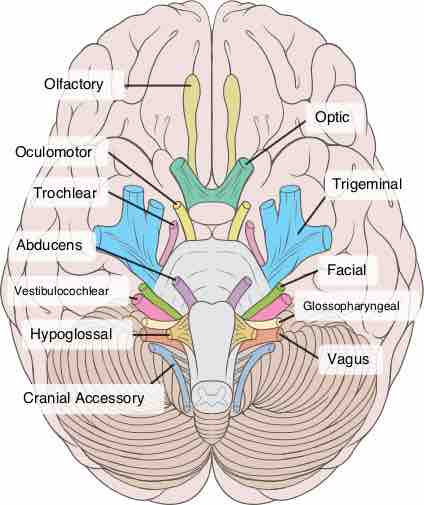Cranial nerves are the nerves that emerge directly from the brain (including the brainstem). In contrast, spinal nerves emerge from segments of the spinal cord. Cranial nerves relay information between the brain and parts of the body, primarily to and from regions of the head and neck.
Cranial Nerve Anatomy and Terminology
Spinal nerves emerge sequentially from the spinal cord with the spinal nerve closest to the head (C1) emerging in the space above the first cervical vertebra. The cranial nerves emerge from the central nervous system above this level.
Each cranial nerve is paired and is present on both sides. The numbering of the cranial nerves is based on the order in which they emerge from the brain, front to back (brainstem).
The terminal nerves, olfactory nerves (I) and optic nerves (II) emerge from the cerebrum or forebrain, and the remaining ten pairs arise from the brainstem, which is the lower part of the brain. The cranial nerves are considered components of the peripheral nervous system.
However, on a structural level, the olfactory, optic, and terminal nerves are more accurately considered part of the central nervous system.
The twelve cranial nerves are shown in the figure below followed by brief descriptions.

The cranial nerves
The locations of the cranial nerves within the brain.
- The olfactory nerve (I): This is instrumental for the sense of smell, it is one of the few nerves that are capable of regeneration.
- The optic nerve (II): This nerve carries visual information from the retina of the eye to the brain.
- The oculomotor nerve (III): This controls most of the eye's movements, the constriction of the pupil, and maintains an open eyelid.
- The trochlear nerve (IV): A motor nerve that innervates the superior oblique muscle of the eye, which controls rotational movement.
- The trigeminal nerve (V): This is responsible for sensation and motor function in the face and mouth.
- The abducens nerve (VI): A motor nerve that innervates the lateral rectus muscle of the eye, which controls lateral movement.
- The facial nerve (VII): This controls the muscles of facial expression, and functions in the conveyance of taste sensations from the anterior two-thirds of the tongue and oral cavity.
- The vestibulocochlear nerve (VIII): This is responsible for transmitting sound and equilibrium (balance) information from the inner ear to the brain.
- The glossopharyngeal nerve (IX): This nerve receives sensory information from the tonsils, the pharynx, the middle ear, and the rest of the tongue.
- The vagus nerve (X): This is responsible for many tasks, including heart rate, gastrointestinal peristalsis, sweating, and muscle movements in the mouth, including speech and keeping the larynx open for breathing.
- The spinal accessory (XI): This nerve controls specific muscles of the shoulder and neck.
- The hypoglossal nerve (XII): This nerve controls the tongue movements of speech, food manipulation, and swallowing.
There are many mnemonic devices to remember the cranial nerves. One that may be helpful is: Old Opie Occasionally Tries Trigonometry And Feels Very Gloomy, Vague And Hypoactive.